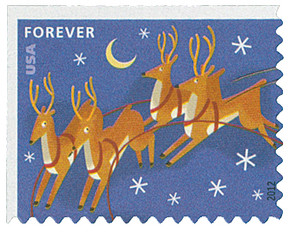
U.S. #4712-15
2012 Santa and Sleigh
Contemporary Christmas
Issue Date: October 13, 2012
City: New York, NY
Quantity: 750,00,000
Printed By: Ashton Potter
Printing Method: Offset
Perforations: Die Cut 11
Color: multicolored
First Printing Of “A Visit From St. Nicholas”
“A Visit from St. Nicholas” was first printed anonymously on December 23, 1823.
Author and professor Clement Clarke Moore is generally considered the author of “A Visit from St. Nicholas,” also known as “The Night Before Christmas.” Clarke claimed he wrote the now-famous poem while riding in a sleigh during a snowy shopping trip.
Moore’s inspiration came from a local Dutch handyman, as well as the historical Saint Nicholas. Many Europeans celebrated the feast of St. Nicholas on December 6. A fourth-century bishop named Nicholas was revered for giving gifts to the poor, and it became a tradition for children to set their shoes by the hearth on the evening before his celebration. During the night, he would fill them with small treats of nuts and fruit. When the Dutch settled in the New World, they brought their customs with them, including visits from Sinterklaas, as they called the saint.
Moore also took inspiration from the writing of his friend, Washington Irving. In his A History of New York, Irving wrote about St. Nicholas riding over the trees in a wagon to deliver presents to children while smoking a pipe.
On December 23, 1823, the poem, “A Visit from St. Nicholas” was published in Troy, New York’s Troy Sentinel with no author listed. Moore had written the poem for his children and hadn’t intended for it to be published. As a respected professor, he didn’t want to be connected to such a fanciful writing.
The poem was popular with readers and continued to be printed in the Sentinel and other papers. Several publishers attributed the poem to Moore, though he didn’t acknowledge it as his own work until 1844. At that time, he was publishing a book a of poetry and his children insisted he include it.
Though Moore published the poem in one of his books, there are some that believe he wasn’t the author. They attribute the poem to Henry Livingston, Jr. While Livingston never claimed authorship during his lifetime, and no printings of the poem have been found with his name attached, some still believe he wrote it. They believe the poem’s meter and phraseology are similar to Livingston’s. Also, Livingston was of Dutch heritage, which would explain the Dutch naming of some of the reindeer. Meanwhile, Moore’s defenders believe he could’ve gotten these Dutch influences from his friend, Washington Irving.
Despite the faction of Livingston supporters, Moore is largely credited as the poem’s author. In the years after its publishing, “A Visit from St. Nicholas” gave Americans the version of Santa we have today – a “jolly old elf” able to slide down chimneys and ride in a magic sleigh. He filled stockings, rather than shoes, with gifts. Instead of having his own feast day, Santa Claus is now a major part of Christmas celebrations.
Click here to read the original article from the Troy Sentinel.









